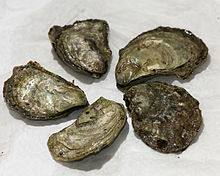Ostrea lurida
| Olympia oyster | |
|---|---|
 |
|
| Scientific classification | |
| Kingdom: | Animalia |
| Phylum: | Mollusca |
| Class: | Bivalvia |
| Order: | Ostreoida |
| Family: | Ostreidae |
| Genus: | Ostrea |
| Species: | O. lurida |
| Binomial name | |
|
Ostrea lurida (Carpenter, 1864) |
|
Ostrea lurida, common name the Olympia oyster, after Olympia, Washington in the Puget Sound area, is a species of edible oyster, a marine bivalve mollusk in the family Ostreidae. This species occurs on the northern Pacific coast of North America. Over the years the role of this edible species of oyster has been partly displaced by the cultivation of non-native edible oyster species.
Ostrea lurida is now known to be separate from a similar-appearing species, Ostrea conchaphila, which occurs further south, south of Baja California, in Mexico. Molecular evidence has recently confirmed the separate status of the two species. However, previously, for a period of time, Ostrea lurida was considered to be merely a junior synonym of Ostrea conchaphila.
O. lurida been found in archaeological excavations along the Central California coast of the Pacific Ocean, demonstrating that it was a marine species exploited by the Native American Chumash people. Also found during excavations are large mounds also known as middens consisting of discarded oyster shells which have been estimated to be at least 3000 years in age.
This bivalve is approximately 6 to 8 centimetres (2.4 to 3.1 in) in length. The shell can be rounded or elongated and is white to purplish black and may be striped with yellow or brown. Unlike most bivalves, the Olympia oyster's shell lacks the periostracum, which is the outermost coating of shell that prevents erosion of the underlying shell. The color of the oyster's flesh is white to a light olive green.
Ostrea lurida oysters lie with their left valve on the substrate, where they are firmly attached. Unlike most bivalves, oysters do not have a foot in adulthood; they also lack an anterior adductor muscle and do not secrete byssal threads, like mussels do. Olympia oysters are suspension feeders, meaning they filter their surrounding water and screen out the phytoplankton they feed on. Olympia oysters filter between 9 and 12 quarts of water each day, but is highly dependent on environmental conditions. This is an essential function to keeping marine waters clean. Oyster beds also provide shelter for anemones, crabs, and other small marine life.
...
Wikipedia
